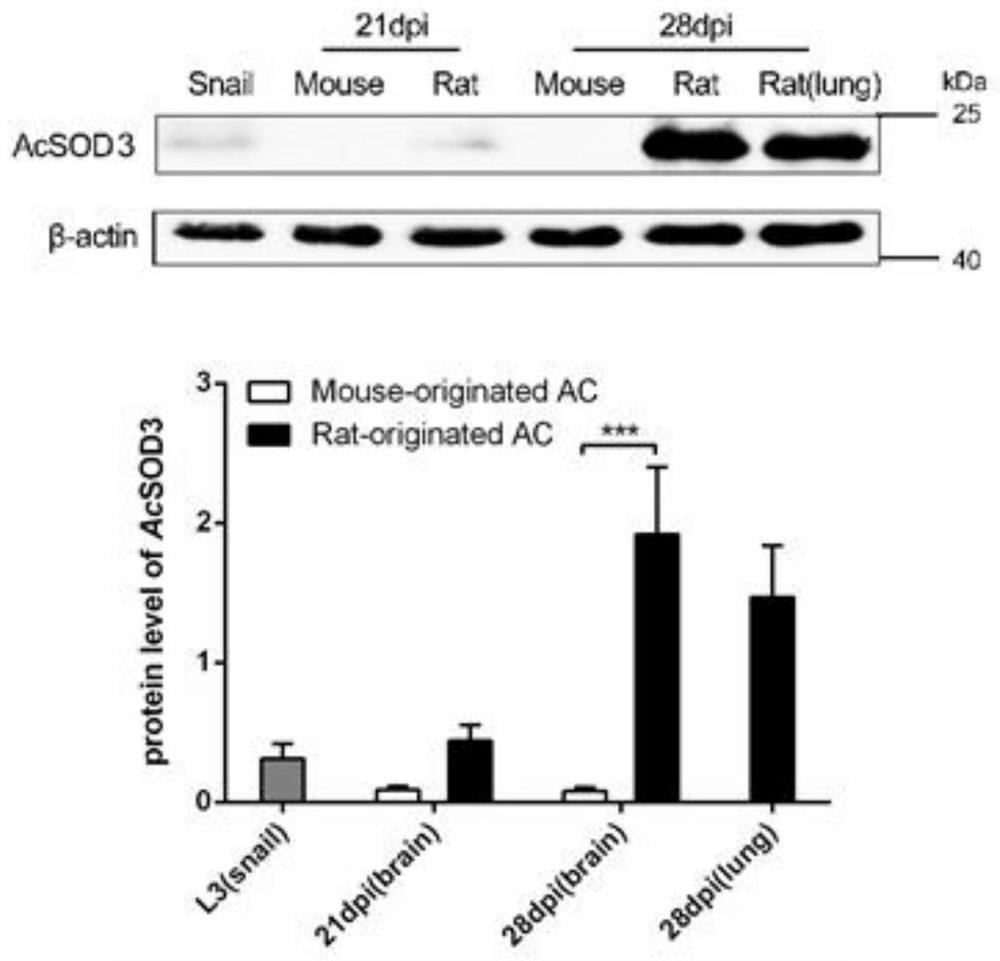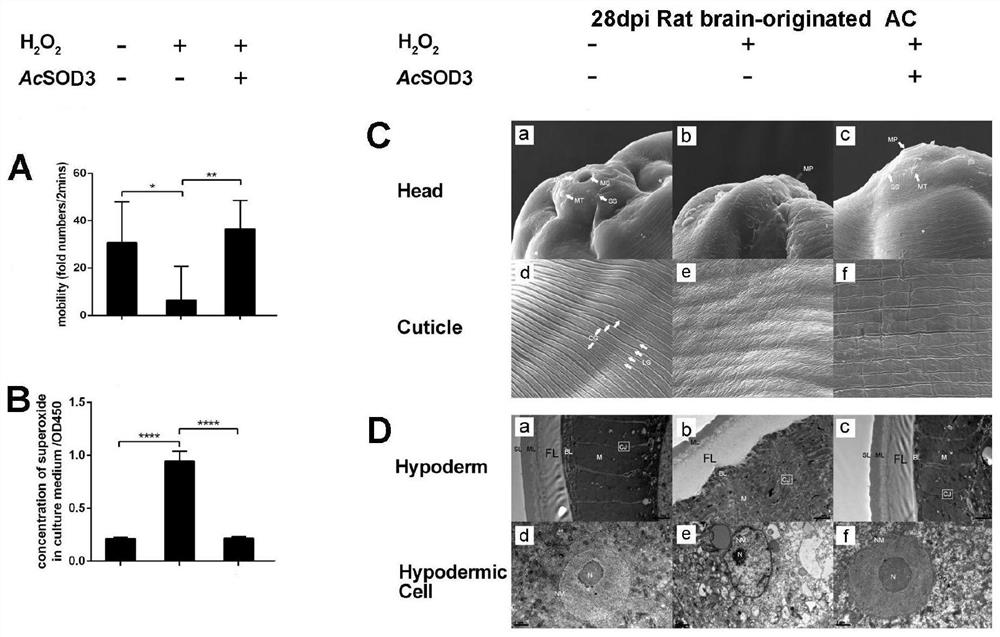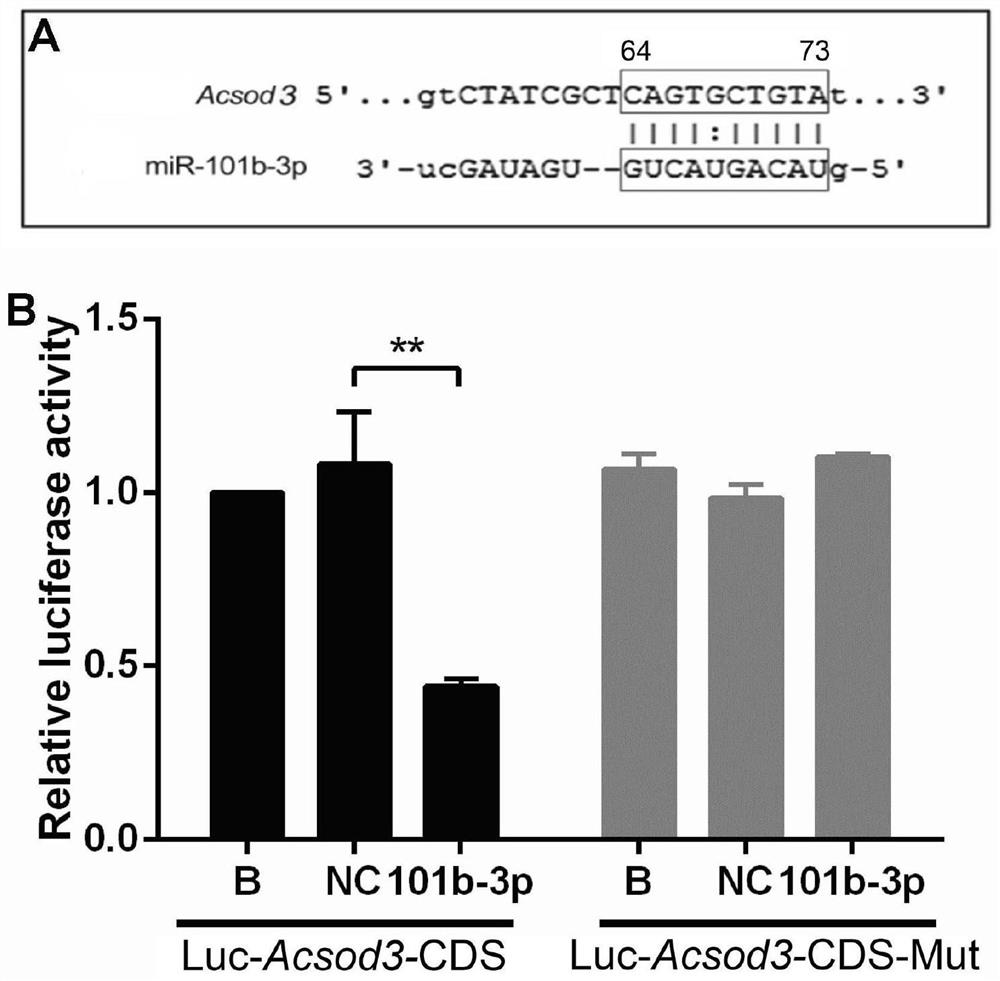Application of mir-101b-3p in the diagnosis and adjuvant treatment of Angiostrongylus cantonensis
1. The technology of mir-101b-3p and Angiostrongylus, which is applied in medical preparations containing active ingredients, biochemical equipment and methods, and microbial measurement/inspection, can solve the problem of diagnosis and treatment without miRNA. Nematode infection and other problems
- Summary
- Abstract
- Description
- Claims
- Application Information
AI Technical Summary
Problems solved by technology
Method used
Image
Examples
Embodiment 1
[0041] Example 1 Obtaining of Angiostrongylus cantonensis body Acsod3
[0042] 1. Experimental materials
[0043] L3-stage larvae of Angiostrongylus cantonensis were obtained from Bacteria glabrata infected with L1-stage larvae for 21 days. 21 and 28 days after infection, the worms were taken out from the brain tissue of mice and rats, and adult worms were taken out from the lungs of rats at the same time 28 days after infection.
[0044] Kit used in the experiment: Premix Taq TM (TaKaRa Taq TM Version 2.0), TIRzol (Invitrogen), RevertAid First Strand cDNA Synthesis Kit (Thermo Scientific).
[0045] Design and synthesize specific Real-time PCR primers, β-actin as an internal reference control, the specific sequence is as follows:
[0046]
[0047] 2. Experimental method
[0048] The specific operation steps of total RNA extraction of Angiostrongylus cantonensis are as follows:
[0049] The sample was crushed by magnetic beads at 4°C. After adding 200 μl TRIzol to the ...
Embodiment 2
[0056] Example 2 Expression characteristics of Acsod3 in Angiostrongylus cantonensis from different host sources
[0057] 1. Experimental materials
[0058] L3-stage larvae of Angiostrongylus cantonensis were obtained from Bacteria glabrata infected with L1-stage larvae for 21 days. 21 and 28 days after infection, the worms were taken out from the brain tissue of mice and rats, and adult worms were taken out from the lungs of rats at the same time 28 days after infection.
[0059] Mouse anti-mouse β-actin monoclonal antibody, goat anti-mouse fluorescent secondary antibody, goat anti-rat fluorescent secondary antibody (Abcam Company), ECL chemiluminescent colorimetric detection of labeled horseradish peroxidase (HRP) antibody and its associated antigen (Millipore).
[0060] 2. Experimental method
[0061] The specific operation steps for detecting the expression level of AcSOD3 by Western blotting are as follows:
[0062] (1) The sample was crushed with magnetic beads at 4°...
Embodiment 3
[0067] Example 3 Antioxidative protective effect of recombinantly expressed AcSOD3 protein
[0068] 1. Experimental materials
[0069] Hydrogen peroxide, AcSOD3 recombinant expression protein treatment worm body, culture plate, DMEM and penicillin (100IU / ml), amphotericin B (0.25μg / ml) and streptomycin (100μg / ml), 5% carbon dioxide incubator.
[0070] 2. Experimental method
[0071] Under in vitro conditions, the antioxidant protective effect of recombinantly expressed AcSOD3 protein on hydrogen peroxide-treated larvae was detected. The specific operation steps are:
[0072] 1. The PCR product recovered by gel electrophoresis purification and the plasmid vector pGEX-4T-1 were digested with restriction endonucleases SmaI and XhoI. The reaction system was as follows: 4 tubes
[0073]
[0074] 37°C, enzyme digestion reaction time 30min. One version of PCR product and one version of plasmid product were detected by 1% agarose gel electrophoresis, and purified with Takara co...
PUM
 Login to View More
Login to View More Abstract
Description
Claims
Application Information
 Login to View More
Login to View More - R&D
- Intellectual Property
- Life Sciences
- Materials
- Tech Scout
- Unparalleled Data Quality
- Higher Quality Content
- 60% Fewer Hallucinations
Browse by: Latest US Patents, China's latest patents, Technical Efficacy Thesaurus, Application Domain, Technology Topic, Popular Technical Reports.
© 2025 PatSnap. All rights reserved.Legal|Privacy policy|Modern Slavery Act Transparency Statement|Sitemap|About US| Contact US: help@patsnap.com



